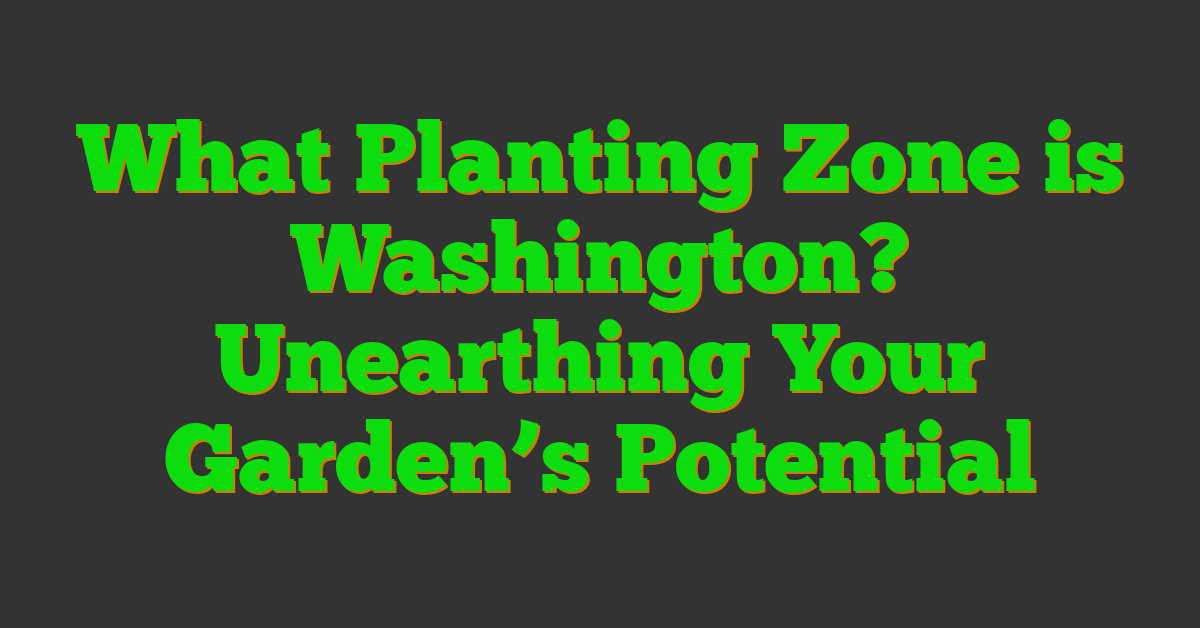So, you’re ready to get your hands dirty and start gardening in Iowa? That’s fantastic! But before you dive in, it’s important to know about the planting zone of your area. Iowa is primarily within USDA Hardiness Zones 5a to 5b. This means that the average minimum winter temperature can range from -20° F to -15° F. Understanding this fact will help you make smart decisions about which plants will thrive best in your garden.

Now, why should you care about planting zones? Well, these zones provide a handy guide for determining which plants are most likely to grow well in your location. It’s all based on average extreme winter temperatures (the coldest temperatures recorded each year). So when you pick up a seed packet or plant tag at your local nursery and see “hardy to zone 5,” now you’ll know what that means.
Keep in mind though, while planting zones can be incredibly useful tools for planning your garden, they aren’t the only factors to consider. You’ll also need to think about things like sunlight exposure and soil conditions. But don’t worry – we’ll be diving into those topics later on. For now, congrats – you’re one step closer to becoming an expert Iowa gardener!
Understanding Planting Zones
Ever wondered why certain plants thrive in your backyard, while others just don’t seem to make it? Well, you’re not alone. The concept of a ‘planting zone’ has been developed by gardeners and horticulturists over years to explain this mystery.
Planting zones, also known as hardiness zones, are geographical areas defined by climatic conditions. They help determine which plants are most likely to thrive at a location. In the United States, these zones are primarily based on average annual minimum winter temperature.
You might be thinking – why does it matter? Picture this: You’ve got your heart set on planting an exotic flower that’s native to Brazil in your Iowa backyard. Without considering planting zones, you could end up with a wilted plant unable to withstand Iowa’s harsh winters.
The U.S Department of Agriculture (USDA) provides a handy Plant Hardiness Zone Map as a guide for gardeners. This map divides North America into 11 separate zones; each zone is 10°F warmer or colder in an average winter than the adjacent one.
Here’s how it works:
- Zone 1: Below -50°F
- Zone 2: -50° to -40°F
- Zone 3: -40° to -30°F
- Zone 4: -30° to -20°F
- Zone 5: -20° to -10°F
- Zone 6: -10° to 0°F
- Zone 7: 0° to +10°F
- Zone 8: +10°to +20°F
- Zone 9: +20°to +30°F
- Zone 10:+30°to +40°F
- Zone11:+40 °F and above
By using this map, you can select plants that are suitable for the climate in your specific zone, ensuring they grow and flourish. So, if you’re in Iowa, knowing your planting zone will help you choose the right plants and have a more successful garden. It’s like having a secret weapon for your green thumb!
What is a Planting Zone?
Ever wondered why some plants thrive in your backyard while others don’t? Well, it’s all about the planting zone. You see, a planting zone, also known as a hardiness zone, is a geographical area that defines how well certain plants can grow based on the climate.
Let me break it down for you. The United States Department of Agriculture (USDA) has divided North America into 13 distinct zones. Each one represents an area of winter hardiness for the plants of agriculture and our natural landscape.
What does this mean exactly? Imagine you’re picking out a plant from your local nursery and notice it’s labeled “Zone 5”. This tells you that the plant should survive winter temperatures in Zone 5, which can dip down to -10 to -20 degrees Fahrenheit.
Check out this nifty table showing each USDA hardiness zone along with their respective average minimum temperature:
| USDA Hardiness Zone | Average Annual Extreme Minimum Temperature |
|---|---|
| 1 | Below -50 degrees F |
| 2a | -50 to -45 degrees F |
| 2b | -45 to -40 degrees F |
| 3a | -40 to -35 degrees F |
| 3b | -35 to -30 degrees F |
| … | … |
You might be thinking: Why bother knowing my planting zone? Here’s why: It helps ensure your garden flourishes by guiding you towards plants that are likely to prosper in your region’s specific conditions. In other words, know your zone before picking up that spade!
Consider yourself lucky if you live in Iowa – it offers quite the variety! It spans from zones 4b through 6a with most areas falling within zones 5a or b. That means Iowans can choose from a wide range of plants that are adaptive to these zones.
Knowing your planting zone is like having a secret weapon in the world of gardening. Once you’ve got this knowledge in your back pocket, you’ll be ready to create your own slice of paradise!
Iowa’s Climate and Its Impact on Gardening
Here’s the scoop. In the heart of America, Iowa boasts a unique climate that can be a gardener’s dream… or sometimes their biggest challenge. Your garden doesn’t just depend on your green thumb; it’s also influenced by the weather patterns in your region.
Let me tell you, Iowa is predominantly classified as Zone 5 according to USDA Plant Hardiness Zone Map, but some parts of Northeastern and Eastern Iowa are in Zone 4b. Are these just numbers? Nope! These zones speak volumes about what plants will thrive in your backyard.
Picture this: You’re dealing with a climate that offers hot summers (average highs around 86°F) and cold winters (average lows about 14°F). That means hardy perennials like Daylilies or Coneflowers might become your best pals in summer while Winterberry Holly could add color to those frosty winter landscapes.
« What Planting Zone is Arizona? Unearthing Your Gardening Potential What Planting Zone is Virginia? A Handy Guide for Your Green Thumb »
Also noteworthy is Iowa’s annual rainfall. It averages around 34 inches, mostly falling between April and September. This rain provides natural irrigation for many plants during growing season but can pose challenges if not managed properly due to waterlogging.
Witnessing tornadoes or severe thunderstorms? Yes, they’re an integral part of living in this state. They may cause temporary damage but they don’t have to ruin your gardening experience if you plan wisely with robust plants and secure structures.
Remember:
- In Zones 4b & 5a/b (Iowa), you’ll find success planting resilient species like Hostas or Black-eyed Susans.
- Regular rainfall is great for thirsty crops like Sweet Corn but too much water can drown certain vegetables or flowers.
- Planning for extreme weathers such as tornadoes means choosing sturdy trees that can withstand high winds, like Oak trees.
So there ya go! Understanding Iowa’s diverse weather conditions will definitely guide you towards successful gardening projects. It’s all about adapting to Mother Nature. Happy planting!
Determining Iowa’s Planting Zone
Let’s dive into the heart of the matter. You’re probably wondering, what exactly is Iowa’s planting zone? Well, if we go by the USDA Hardiness Zone Map, it appears that most of Iowa falls in zones 4b to 5b. Now, you might be asking yourself, “What does that even mean?”
Well, imagine you’re staring at a palette with various shades of green. Each shade represents a different zone on the USDA map and is linked to specific temperature ranges. These zones help gardeners like us know which plants are likely to survive our winters.
For instance, if your yard sits in zone 4b (like much of northwestern Iowa), winter temperatures can drop as low as -25 degrees Fahrenheit! Brrr! But don’t let those chilly numbers scare you away from your gardening gloves yet.
Here’s an interesting fact for you: Many hardy perennial plants can withstand those frigid temperatures without batting an eyelash! We’re talking about lovely shrubs like Juniper and Arborvitae or vibrant flowers such as Daylilies and Phlox.
On the other hand, most of southeastern Iowa enjoys milder winters in zone 5b where temperatures rarely dip below -15 degrees Fahrenheit. This slightly warmer climate opens up more options for plant selection including pretty peonies and lush hostas.
But remember folks—it’s not just about picking out plants that survive but selecting ones that will thrive in your particular environment!
Here’s a quick look at some common plants suitable for each zone:
Zone 4b
- Juniper
- Arborvitae
- Daylilies
- Phlox
Zone 5b
- Peonies
- Hostas
With this information under your belt, now you can confidently stroll down those nursery aisles knowing exactly what to look for based on your specific planting zone. Happy gardening, folks!
Alright, let’s jump right in! Did you know that Iowa falls primarily in USDA hardiness zones 5a to 5b? What does this mean for your gardening efforts, you ask? Well, it basically dictates what plants are likely to thrive in your garden. The USDA has categorized regions into planting zones based on their average annual minimum winter temperature. This piece of info is quite handy when deciding which plants best suit your area.
If you’re new to gardening or simply want a refresher course, here’s how this works: Each plant has its own optimal growth zone. If the plant’s preferred zone matches up with Iowa’s zone 5 status, bingo! It stands a great chance of flourishing under your care.
So what are some examples of plants that love the conditions found in Iowa? Let me give ya the scoop:
- Perennials like Astilbe and Daylily
- Trees such as Red Maple and River Birch
- Shrubs including Hydrangea and Ninebark
But don’t be fooled into thinking that these are the only options available to you. There’s a whole world of plants out there that can tolerate conditions outside their optimal growth zones with just a little extra tender loving care from yours truly!
Understanding how to leverage Iowa’s planting zone will also help you plan better for each gardening season. For instance, knowing when the last frost typically occurs can guide you on when it’s time to start seeds inside or prepare seedlings for transplantation outdoors.
Here’s an example timeline for any Iowan gardener:
- Early March: Start seeds indoors.
- Late April – Early May: After danger of frost passes, transplant seedlings outdoors.
- June – September: Maintain garden; watch out for pests and diseases.
- October – November: Prepare garden beds for winter; mulch perennials.
When it comes down to it, using Iowa’s planting zone to your advantage can make all the difference between a good garden and a great one. Remember – knowledge is power in the world of gardening!
Common Plants Suitable for Iowa’s Planting Zone
C’mon, let’s take a walk in the greenery! When it comes to planting in the heartland of America – Iowa, you’ve got a plethora of options. It’s all thanks to its unique climate and planting zone.
You’re probably wondering what this ‘planting zone’ is all about. Well, simply put, it’s part of a system developed by USDA (United States Department of Agriculture) that helps gardeners and landscapers identify plants most likely to thrive at their location. The great state of Iowa falls largely into Zones 4b through 5b. This means that if you’re considering adding some green to your yard there, certain plants will naturally be more suited than others.
So what are these common plants? Let’s dive in!
- Black Eyed Susan: This classic American perennial bursts with bright yellow flowers and black centers from midsummer through fall – perfect for our Iowan summers.
- Switchgrass: Native to the prairie regions like ours here in Iowa, switchgrass offers year-round interest with its tall stems and feathery-seeded blooms.
- Autumn Blaze Maple: Looking for something bigger? You can’t go wrong with Autumn Blaze Maple trees! They’re known for their fast growth rate and vibrant fall colors.
- Hostas: If you have shady spots in your yard, hostas are your friends. These shade-loving perennials come in various sizes and leaf colors.
Remember folks, while these plants may be common choices for Iowan landscapes, they’re not the only ones out there. Your choices don’t stop here; feel free to explore other options as well! Maybe try mixing up native species with some non-native ones or playing around with different textures and colors. As long as the plants are suitable for zones 4b-5b, your imagination is really the limit!
Just remember, gardening isn’t just about the plants. It’s also about creating a space where you and nature can exist together in harmony. So don’t stress too much about getting it ‘right’. Instead, focus on creating an environment that suits you and your lifestyle! Happy planting, Iowa friends!
Challenges in the Iowa Growing Season & How to Overcome Them
Get ready, green thumbs! Planting in Iowa presents its own unique set of challenges. But don’t worry, we’ve got you covered with some pro tips on how to navigate through them.
First off, let’s talk about frost. It’s no secret that Iowa winters can be harsh, and early spring isn’t always a picnic either. This means that tender plants could be at risk if you plant too early in the season. To outsmart Mother Nature, keep an eye on the forecast and consider starting your seeds indoors or invest in some frost blankets for protection.
Next up is water management. Now, while it’s true that Iowa gets plenty of rainfall during the growing season (about 34 inches annually), there are still periods where drought can strike. So what’s a gardener to do? Here’s what:
- Invest in a rain barrel to collect runoff from your roof
- Mulch around your plants to help retain soil moisture
- Consider planting native species which are adapted to local climate conditions
Now let’s not forget about pests – they’re a challenge everywhere! In Iowa specifically, you’ll have to watch out for critters like Japanese beetles and aphids. Don’t fret though; integrated pest management techniques such as introducing beneficial insects or using organic pesticides can help keep these buggers at bay.
Finally, we come across our last hurdle – weeds. They thrive just about anywhere but seem particularly fond of Iowan soil! However, regular weeding and use of natural herbicides should keep them under control quite efficiently.
Remember folks; every garden has its challenges but overcoming them is part of the fun – AND gives us bragging rights at the next neighborhood BBQ! With these tips up your sleeve, you’ll be well-prepared for gardening success in the Hawkeye State.
Concluding Thoughts on Iowa’s Planting Zones
Alright, you’ve come a long way in understanding the planting zones of Iowa. It’s been quite an adventure, hasn’t it? Let’s wrap up what we’ve learned together.
Iowa is primarily situated in USDA Hardiness Zones 5a to 5b. That means it’s got a fairly versatile climate for gardening, with winter lows ranging from -20°F to -15°F. But remember, these are just guidelines and Mother Nature doesn’t always stick to the rules!
You’ll find that several plant species thrive in this zone, including:
- Apple Trees
- Cherry Blossom Trees
- Blue Spruces
Now let’s not forget about the AHS Heat Zone map either! According to this system, Iowa falls between Zones 4-7. This implies that your plants will face anywhere from 14 to 60 days of temperatures over 86°F.
So, what does all this mean for you as a garden lover or landscape designer?
Well firstly, it means that you’ve got a pretty great range of plants to play around with! You’re also going to need adaptive strategies during particularly hot or cold spells. After all, protecting your green buddies from extreme weather conditions is part and parcel of gardening.
Now don’t be afraid to experiment too! Trial and error is part of the process and there’s nothing more rewarding than seeing a plant flourish under your care.
In summary:
- Your main focus should be on plants suitable for USDA Zones 5a-5b.
- Be prepared for heat waves as per AHS Heat Zone map (Zones 4-7).
- Get creative and don’t shy away from experimenting with different plants!
Remember gardening isn’t just about following rules; it’s about nurturing life and expressing yourself creatively through nature. So put on those gloves, grab your shovel – let’s make Iowa even greener than it already is!











